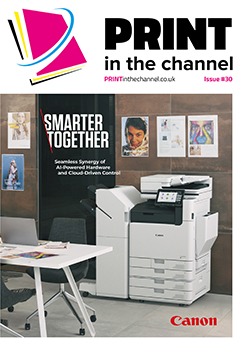Artificial intelligence is more than just a buzzword. By being installed on a variety of a devices – including printers – is it making a tangible difference to many businesses. Resellers now have to help customers to embark on their AI print journey.
Artificial intelligence (AI) has been the breakout technology of the past couple of years, ever since ChatGPT was launched by OpenAI in November 2022 and gained more than 100 million users within two months.
Now, the technology is proving its worth for businesses in many ways and changing how offices work – and that includes printers.
There are various advantages that AI is bringing to print and printers. “Over time, broadly speaking we envisage that AI and machine learning (ML) will better analyse print usage patterns, while improving tracking and accountability, and we expect that AI will drive further reductions in waste,” says Stuart Brookes, EMEA head of sales and channel at PaperCut.
“Predictive maintenance and automated print supply management will be improved and print job optimisation will be simplified. We also expect to see enhanced security thanks to AI-based threat detection.”
Workflow and personalisation
Kerry Rush, product marketing manager at Sharp UK, adds that while AI is still in its infancy with print, one of the major benefits of it is capture and workflow. “While this is not completely new to print, the advancements in this area are certainly coming faster than ever before,” she says. “AI and workflows will continue to make processes simpler, more efficient and faster than ever.
“As this technology becomes more embedded, document classification and information extraction will become more efficient, which means there will be even less barriers for organisations wanting to digitise their paper documents with ease.”
Kerry adds that AI will also enable large-scale personalisation, for example, allowing printers to produce customised prints tailored to individual preferences without compromising speed or quality. “AI-powered quality control systems can ensure high standards by detecting and correcting errors in real-time,” she says. “This ensures that every print meets the highest quality standards, reducing waste and increasing customer satisfaction.
“However, we are still in the early days, and it will be some time still before the industry will see widespread adoption of the technology.”
That said, there are already some AI-enabled printers on the market, such as the Xerox AltaLink 8200 series multifunctional printers (MFPs). “One benefit of these is the opportunity for users to save time on repetitive and complex tasks,” says Nico Korlaar, office business manager at Xerox. “Our MFPs contain algorithms that identify and learn frequently executed or complex tasks, such as copying or emailing, and then propose 1-Touch shortcuts to save time and utilise later. It even reminds the user at the device of the 1-Touch shortcut should they forget to use it next time.
“Other benefits AI can bring to printers and printing are cloud-connected services and specific apps developed to help customers boost productivity by automating and performing tasks faster and more efficiently.”
Big difference
Stuart says that with the cumulative benefits that AI and ML bring to print devices, there’s scope for businesses to realise tangible print-related cost, efficiency and sustainability benefits, while making print even easier for today’s hybrid workplaces and users.
Kerry adds that AI will aid businesses with efficiency, taking away some of the more manual processes and giving workers time back to concentrate on more meaningful tasks. “This can make a huge impact to the overall productivity and efficiency of an organisation,” she says.
“In addition, vendors and partners should also be looking at how they can use AI within their own business. Not only will this help them streamline their own processes, but it will also support them in propositioning the benefits of this technology to their own clients.”
Nico adds that many of these AI-driven applications are cloud-based versus on-device, so can be independent of the device used for output.
“Another area where AI can assist a business in printing is compliance with directives such as GDPR; for example, with the Auto Redaction App on the Xerox AltaLink 8200 series, with this a business can quickly redact and suppress customer identifiable information, thereby reducing the liability of this information to be shared or accessed by third parties.”
Customer demand
But while the benefits of AI to printers and print are becoming clearer, many customers remain sceptical or unaware of these benefits.
“Many customers are still at the early stages of the AI acceptance curve,” Stuart says. “Quite rightly they’re focusing on any risk – real or existential – that AI may pose, so they may not yet be at the point where they’re viewing AI in the context of the benefits it can bring to print. I don’t think they’re far off it though, given the influx of new hardware devices and software services that are supplemented by AI.
“If a fleet is due for a refresh soon, we’d advise that customers speak to their print resellers about on-device AI; it would be a pity to skip AI-driven print improvements for a fleet generation.”
Nico adds that customers typically need devices to help them in their business, whether for mission-critical applications or supporting work processes. “Especially in the latter, customers are looking for more productive ways to work and ensure the secure accessibility of tools and content,” he says.
“AI can deliver many benefits even in simple steps, as we are demonstrating with the Xerox AltaLink 8200 series, whether it is through learning algorithms which develop and propose one-touch shortcuts to be programmed or through cloud-assisted apps automating tasks, like recognising critical content for redaction or summarising.
“Customers are aware of what they are looking for in terms of benefits, but not necessarily of what is possible or indeed available; here lies the role of the reseller to help them by offering the right combination of AI-assisted platforms, services, software and applications for their business.”
Education is key
Another key role for resellers regarding AI is educating customers about it and its benefits in print, adds Kerry.
“As its use in print becomes more common, we are prepared to support and train our clients appropriately, answering their questions and supporting them with secure implementation,” she says. “For most clients, AI is still new and unfamiliar to them and the extent of what AI can do, not just in print, is still unknown. That’s why it’s important for us as their technology partner, to guide them on their AI journey and provide expert advice.
“While its natural for people to have concerns around AI, if resellers focus on the benefits of AI, such as cost reduction and productivity, it will encourage openness to the use of AI in print and other technology.”
Approaching conversations
While education is an important part of the reseller role when it comes to AI in print, there are also various benefits they should be highlighting to customers.
“Private and public sector organisations tend to want the same core benefits from a new service or solution; it needs to offer value for money, deliver a tangible ROI, be flexible, scalable and easy to maintain,” says Stuart. “Many print management solutions already deliver against those requirements while also delivering cost, efficiency and sustainability benefits. Done well, AI will serve to amplify those benefits, rather than bringing anything radical to the print party. Setting expectations will be key if customers are to appreciate how AI improves print in the long-term.”
Meanwhile, Ian Fox, channel solutions and services specialist at Xerox, says that one potential approach would be understanding if their customers are already looking to use AI within any part of their business and not just print. “This could be used as a conversation starter to understand which areas and if they have any concerns about adopting these new technologies,” he says. “For example, are you engaged in any internal projects utilising AI within your organisation?”
A reseller can then follow up, depending on what the answer is. “If the answer is yes, then they can ask several questions, such as ‘where did you identify maximum gains by implementing AI within your internal processes? What concerns do you have about adopting AI? What controls do you intend to implement to ensure that AI content is effectively validated before use? Have you considered using AI to optimise your labour-intensive document workflows, such as scanning, indexing, redaction and storage?’”
Ian adds they can talk about AI-enabled devices and solutions and how they can enhance productivity in many areas.
“But if the answer is no, then the reseller can open a conversation about using expertise, products and services to help them along their journey into the world of AI,” he says.
“This might be about how to increase device uptime or how they may be able to streamline some internal processes using apps and devices.”
Future
As AI continues to develop, it is likely to have a growing influence on print. “As we are all asked to do more with less, AI will likely continue to disrupt our industry, removing or streamlining many document-intensive processes,” says Ian.
“Where physical print remains a requirement, better connectivity and AI data analysis will allow for improved onsite call avoidance and first-time fix rates as engineers are provided with meaningful IoT data detailing the causes of failures, allowing them access to the right components to repair the device the first time.
“Increased automation and extraction capabilities will improve physical and digital document workflows. This will mean that employees spend less time on menial tasks such as re-keying data, manual filing, and routing information.”
But Ian notes that we should also be mindful of security risks that will become prevalent as generative AI continues to provide new opportunities for bad actors to spoof identities. “For example, creating convincing real-time audio and video content may convince unsuspecting users to reveal privileged information,” they say. “User education of these threats and well-thought-out security policies for every device endpoint must be considered. Ensuring devices are configured with minimal open ports and that they are always running the latest firmware and security patches will be crucial in reducing the potential attack surface of networks.”
Ian adds that AI will continue to be added to applications that drive more customer value. “This will enable customers to increase their productivity, drive improved service response through predictive algorithms, automate intelligence-based supply replenishment, enhance their security or find new ways to interact with their customers, even beyond print, such as in graphic communications,” he says.
Huge appetite
Kerry adds that the current appetite for AI is huge. “It’s likely we will see an increase in the introduction of AI into print, be this capture, personalisation, workflow and automations and predictive maintenance systems that not only anticipate issues but also optimise printer performance and quality control in real-time,” she says.
Of course, with a developing technology, predictions are difficult to make. “We’re experiencing profound innovation at a rapid, near-breathless, pace in AI,” says Stuart. “As such, it’s a brave company that’s prepared to say with confidence what the landscape will look like for the print management software industry in 18 months.
“While we’re comfortable making some assumptions about how AI will impact some aspects of print – such as data insights – right now, there’s much uncertainty about just how transformative the technology will be. If nothing else, the next 18 months in print are going to be fascinating, and there’s no doubt that there will be a few surprises along the way.”










